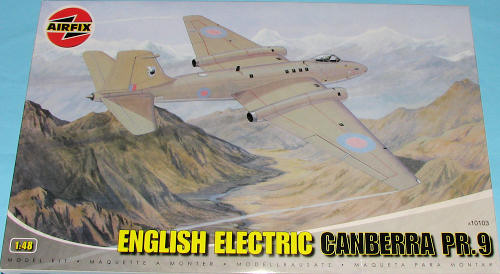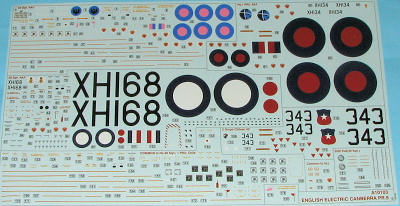
Airfix 1/48 Canberra PR.9
| KIT #: | 10103 |
| PRICE: | 5800 yen at www.hlj.com |
| DECALS: | Four options |
| REVIEWER: | Scott Van Aken |
| NOTES: |

| HISTORY |
The Canberra PR.9 was a photo-reconnaissance version based on B(I).8 with fuselage stretched to 68 ft (27.72 m), wingspan increased by 4 ft (1.22 m), and Avon R.A.27 engines with 10,030 lbf (44.6 kN) of thrust. 23 built by Short Brothers & Harland. 3 transferred to Chile after the Falklands War as partial payment (bribe) for their assistance during that conflict.
This variant was the last to fly with the RAF's 39 Squadron. A ceremony to mark the closure of this unit took place at RAF Marham on Friday 28 July 2006. The ceremony included a flypast by a Canberra PR9 on its last ever sortie. RAF Canberras made their final flights on 31 July when three were delivered to their new home with Delta Jets at Kemble. They have been purchased by private agencies and will be kept serviceable pending developments which might include contract work.
After the Canberra left RAF service, the other full-time military operator, the Indian Air Force, announced the withdrawal of the Canberra from combat service from March 2007. The last Canberras operated by the Indian Air Force have retired after a 50 year career. Other Canberras (though not PR.9s) are retained by the Air Force of Peru and several ex-RAF machines and RB-57s are flying in the US for research and mapping work.
About ten airworthy Canberras are in private hands today, and are a popular feature at flying displays.
| THE KIT |
This is Airfix's second 1/48 Canberra kit and they wisely chose another variant on which to use many of the pieces from their earlier B(I).8 kit. For those concerned that Airfix may have just used the shorter B(I).8 fuselage, I can put your worries to rest as it is, indeed, the longer version. Frankly, there are a number of detail differences in the two fuselages so it would be difficult to pass off one for the other.
This is the first PR.9 kit of any sort done in mainstream injection molding since the venerable 1/72 Matchbox kit of 30 years ago. The molding is top notch, as you'd expect from a modern kit with finely engraved panel lines and crisp edges. Due to the huge mass of parts and the lack of a sprue diagram in the instructions, I'm unable to show you the parts layout, but inspection showed no molding glitches.
As the PR.9 was built in such small numbers (less than 50), there are not a ton of options available. About the only thing offered are tip tanks (not always carried) and what appears to be a flare/chaff dispenser pod for under the wings. There are also two variations on the bomb bay door to provide for different camera installations, though there is no indication as to which one is used with which set of markings. I guess it really doesn't matter. A final options are to have the flaps displayed in the lowered position or have the canopy open. Looking through a lot of photos, I rarely saw either one in anything besides the closed position, though it is nice to have.
I should also mention that the kit has a very nicely done cockpit section with both the pilot and sensor operator's positions nicely outfitted for a stock kit. This includes well done instrument panel and side wall detailing. The kit will require considerable weight (100 grams) to prevent nose sitting, but there seems to be enough room to put it, thanks to the solid nose
 The instructions are well done and provide Humbrol paint references. At least, that is what they appear to be as it is never really clearly spelled out. No generic names are provided so you'll need some sort of cross reference chart if using other paints. Markings are given for four aircraft in the three schemes carried by this version. The markings and camouflage guide is superbly done and in full color. One is a 58 Squadron plane from 1963 in overall high speed silver with the full color roundels and fin flash. In the later camouflaged scheme of dark green/dark sea grey and a light grey is an aircraft from 1 PRU and another with the Chilean Air Force. The final scheme is hemp over a light grey with the pastel roundels as used with 39 Squadron during its final years. As a note, one can also do the 1 PRU plane in the hemp scheme as well and even with the blue/red roundels. A search of various internet sites will provide some of these options. The huge decal sheet fills the bottom of the box and is superbly printed. So much so that aftermarket is probably not needed.
The instructions are well done and provide Humbrol paint references. At least, that is what they appear to be as it is never really clearly spelled out. No generic names are provided so you'll need some sort of cross reference chart if using other paints. Markings are given for four aircraft in the three schemes carried by this version. The markings and camouflage guide is superbly done and in full color. One is a 58 Squadron plane from 1963 in overall high speed silver with the full color roundels and fin flash. In the later camouflaged scheme of dark green/dark sea grey and a light grey is an aircraft from 1 PRU and another with the Chilean Air Force. The final scheme is hemp over a light grey with the pastel roundels as used with 39 Squadron during its final years. As a note, one can also do the 1 PRU plane in the hemp scheme as well and even with the blue/red roundels. A search of various internet sites will provide some of these options. The huge decal sheet fills the bottom of the box and is superbly printed. So much so that aftermarket is probably not needed.
| CONCLUSIONS |
I'm quite pleased that Airfix has decided to embark on a series of Canberras. Their release schedule is a wise one, getting the more unique variants out to the public before digging in with the more common versions. I see from several web sites that this kit has sold out so you need to grab yours while the grabbing is good.
| REFERENCES |
http://en.wikipedia.org March 2009
My thanks to www.hlj.com for the preview kit. Visit them for many other superb kits and accessories. For current exchange rates, visit www.xe.com If you would like your product reviewed fairly and fairly quickly, please contact the editor or see other details in the